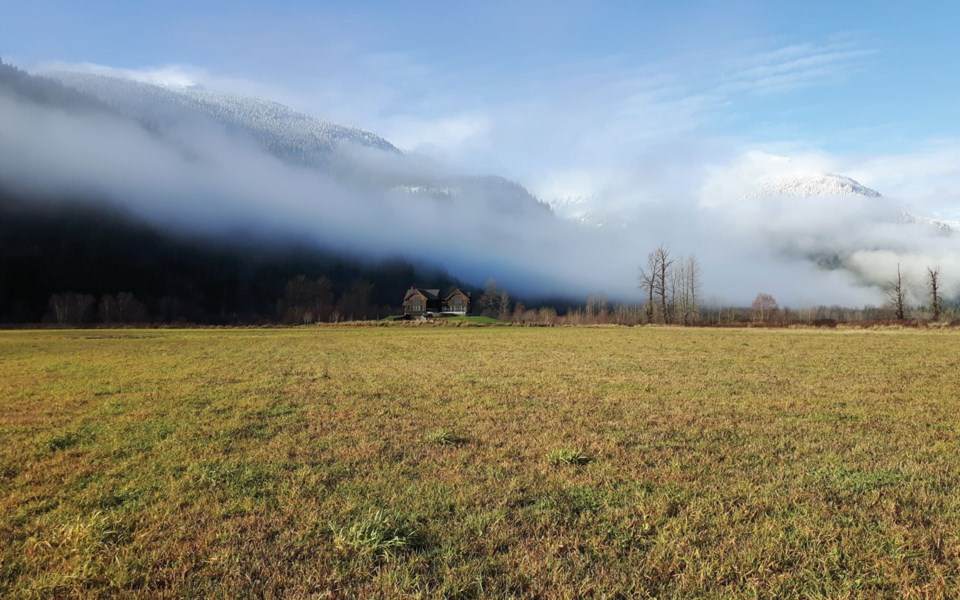A group of Pemberton farmers concerned about productive farmland being taken out of production by non-farmers in the Pemberton Valley are looking to the province to strengthen its rules and regulations governing the Agricultural Land Reserve (ALR).
Potato farmer and author Anna Helmer wants the province to guard against the construction of mansions in the middle of productive agricultural fields that fall within the ALR.
"They've left it up to local government, and it's too hard for local government (to restrict)," she said.
Established in the 1970s, the ALR is a 4.6-million-hectare provincial zone where agriculture is recognized as the primary use and non-agricultural uses are restricted. It is administered by the Agricultural Land Commission (ALC) and covers parts of the Pemberton Valley. Non-farmers are permitted to purchase ALR land.
According to Helmer and other farmers Pique spoke to, the ALC's ability to prevent the incursion of industrial uses and residential development was diminished under years of BC Liberal Party rule.
Every time someone builds a house in the middle of a field, they have to lay down fill, Helmer said. "You're obviously not a farmer if you're dumping fill on great soil—you obviously wouldn't do that," she said.
Non-farmers purchasing farmland has also driven up land prices in the Pemberton Valley, Helmer said, estimating the land adjacent to her property would be in the million-dollar range.
"Obviously selling potatoes is not going to pay for that," she said.
Helmer and other Pemberton farmers are therefore hoping that the province's new NDP-led government will beef up the ALC and implement stronger rules and regulations on ALR land.
In January, Agriculture Minister Lana Popham, tasked a group of nine people with a mix of farming and policy experience to "revitalize" the ALC and ALR.
The advisory committee produced a consultation paper and has met with stakeholders in nine communities. It is also considering the results of an online survey, which is open until the end of April.
In an interview with Pique, Popham said she is open to considering any potential recommendations the advisory committee brings forward, including making changes to the number of agri-tourism events permitted on ALR lands and bringing in restrictions on the construction of new homes.
Popham stressed the need to protect farmland, especially in light of global warming and the food security issue.
Over the last 50 years, we've seen "an erosion" of the ALR because of development, she said.
Under the BC Liberals the ALR was split into two zones—a move that was seen as a way to allow increased development on agricultural land in the northern and the eastern parts of B.C.
"I was not a big fan of those changes because I didn't think it allowed the ALC to uphold its mandate as it should," said Popham, who served as the NDP's agriculture critic.
"There is an appetite to have the reserve changed back to one zone. In my view, that's the more effective land use tool than splitting it into two. The split caused an enormous amount of confusion, and it sounds like it caused a lot more work to the Agricultural Land Commission."
Any proposed changes could lead to strong opposition from some farmers and landowners, however. The Squamish-Lillooet Regional District (SLRD) is currently in the process of updating its bylaws for the so-called "Pemberton fringe," an area that oversees 110 properties surrounding the Village of Pemberton with an average parcel size of 4.45 hectares that sit on ALR land.
The move would bring the bylaws that govern them in line with ALC rules and regulations and bring about some additional rules and regulations regarding home size and siting, requiring that there be a maximum setback from the front parcel line to the rear of the house of 75 metres.
The proposed changes, however, have generated strong opposition. Last week, Pique interviewed Kevin Damaskie, who wrote a letter on behalf of 21 landowners in the area decrying the proposed changes, and a group called "Future Area C Engagement" has been established in opposition to the bylaws.
(See Pique's letters to the editor section for more details on the group.)
ALR-related issues have long been a hot-button issue in the Lower Mainland.
Last year, a farm sold for more than 100 times its assessed value in Richmond, which is currently considering bringing in restrictions on the size of homes that can be built on farm land.
At a March 27 council meeting, Richmond council heard both opponents and supporters of new rules meant to rein in the maximum allowable size—from 10,763 square feet to 5,382 square feet.
As of now, the ALC has no tools to forcibly stop the construction of "monster homes," said Popham. "We need the tools in place to protect farmland and encourage farming," she said.
Jennifer Dyson, a former commissioner with the ALC who operates a water buffalo dairy farm on Vancouver Island and is leading the nine-person "revitalization" committee, said that the committee has heard from a wide range of voices.
"The big things we're hearing throughout the province is that (the changes) need to be something good for agriculture ... There's growing pressure on agricultural land, and we must support farm and ranch businesses," she said, adding that keeping farmland is crucial.
"Everything that happens on the land should be ancillary to agriculture ... If the brewery is the business and you've only got an acre of barley, tell me what's good for agriculture?"
A final report from the advisory committee will be provided to the legislature before the fall of 2018, with legislative changes targeted for late 2018 or early 2019.
The advisory committee is accepting feedback up until April 30. To chime in, visit the ALC's website: engage.gov.bc.ca/agriculturallandreserve/.
A public information meeting on Electoral Area C Zoning Amendment Bylaw No. 1549-2017 will be held on Wednesday, April 11 from 6:30 to 9 p.m. in the Great Hall at the Pemberton and District Community Centre (located at 7390 Cottonwood St.).




